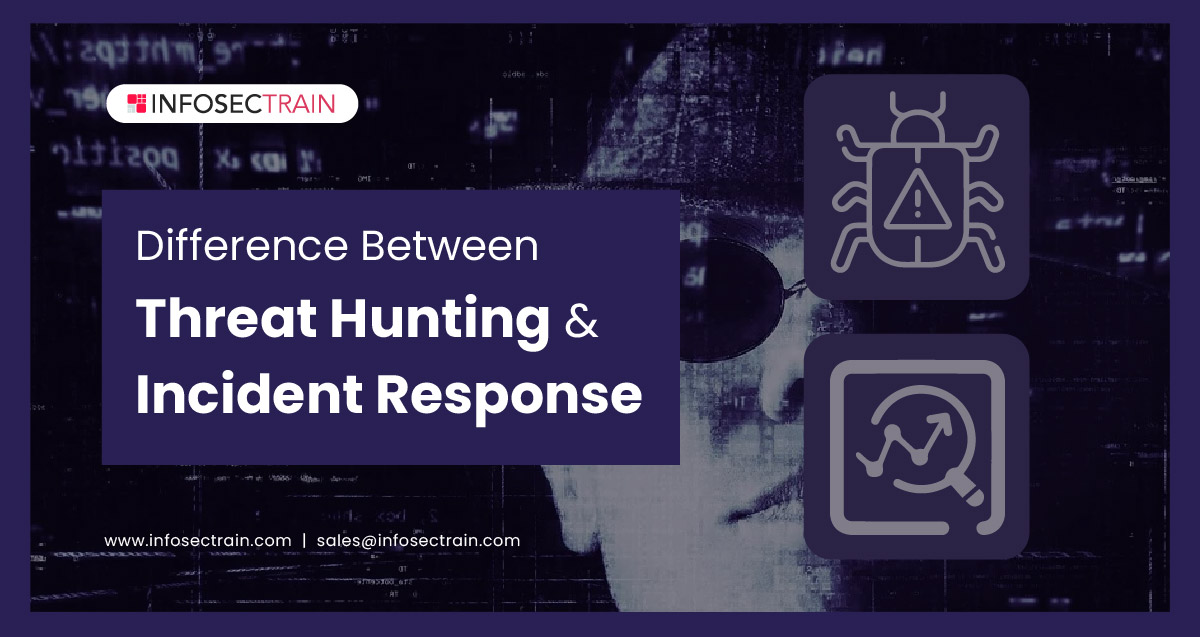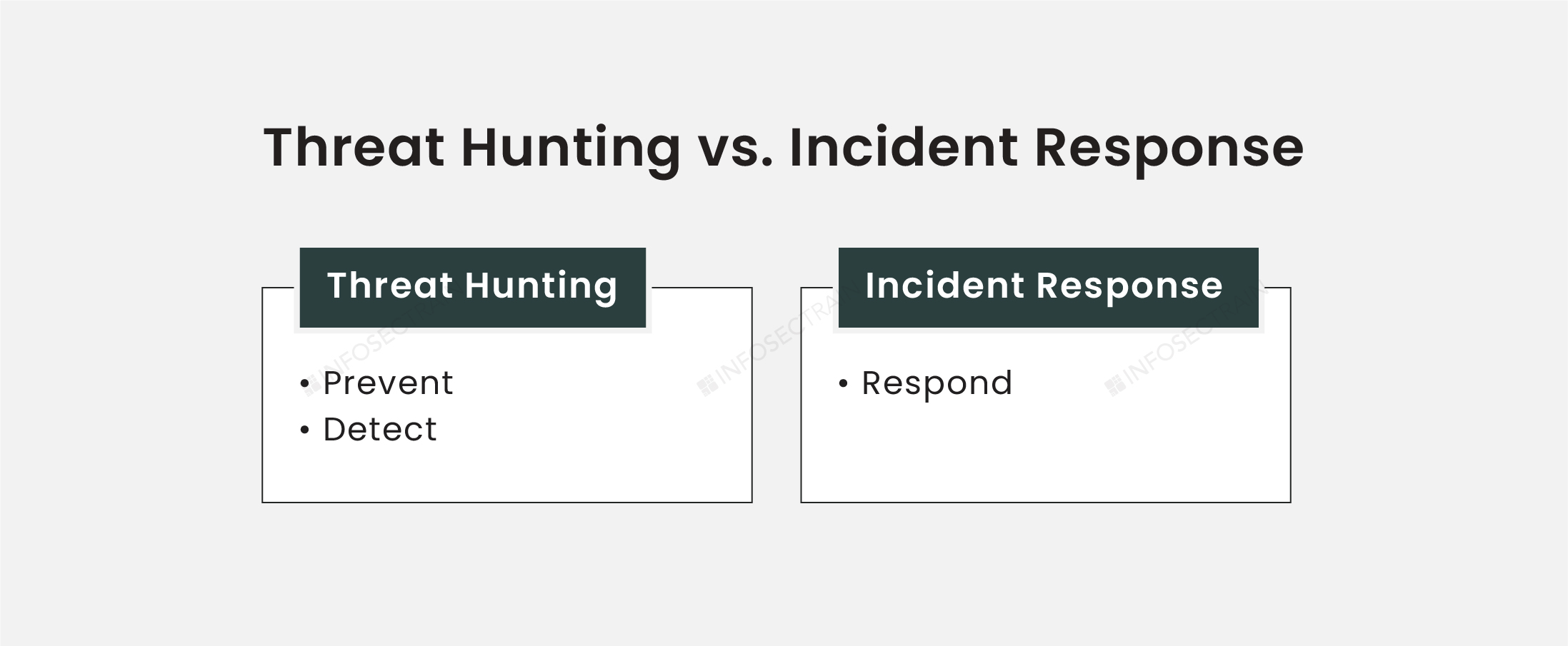Difference Between Threat Hunting and Incident Response
A malicious attacker may attack any organization, regardless of size, in search of financial gain or information. The situation is critical, and 68% of companies believe their cybersecurity risks are worsening. In the middle of this, it is essential to implement multiple threat monitoring and mitigation strategies. So let’s understand the threat hunting and incident response in this article.

Table of Contents
Understanding Threat Hunting and Incident Response
Threat Hunting
Incident response
Threat Hunting vs. Incident Response
Understanding Threat Hunting and Incident Response
Threat hunting and incident response are emerging approaches to threat monitoring and mitigation. These strategies enable an organization to be attentive and preventive of itself from cyber threats, security breaches, and system vulnerabilities.
While the concepts of threat hunting and incident response are frequently used together, they have different meanings, approaches, and objectives when it comes to adopting cybersecurity within an enterprise.
Threat Hunting
Threat hunting is a cybersecurity activity that attempts to find and prevent malicious activity in an organization’s information systems using preventive techniques and advanced technologies. It works on the assumption that attackers have already exploited the organization’s essential systems. This assumption is predicated on the fact that these attackers have already discovered a means to avoid detection by existing tools and techniques. Therefore an active effort is necessary to root out the threats.
Incident Response
An organization’s methodology to respond to and manage a cyberattack is incident response. A cyberattack or security breach may cause customer chaos, copyright issues, organizational resources and time hampering, and degrading brand equity. The objective of incident response is to minimize damage and go back to normal as soon as possible. After a security breach, having a well-defined incident response strategy can help limit attack damage and save expenses and time.
In brief, both threat hunting and incident response are advantageous to any cybersecurity system. Threat hunting protects an organization from cyber attacks and data theft, and incident response helps organizations mitigate and manage those attacks.
Threat Hunting vs. Incident Response
The vulnerability assessment scenario is constantly evolving, resulting in a dramatic increase in the number of security breaches emerging every day. And these cyber attacks are capable enough of causing severe reputational and financial losses to any organization. These kinds of cyber-attacks cause harm to the reputation and economic loss, and the recovery process and the quantity of money required are typically enough to destroy that organization.
A thorough threat hunting and incident response plan is one way to ensure security from these kinds of long-term collapsing damages. Now, let’s look at the differences between threat hunting and incident response from several perspectives.
1. Goal
Let’s look at the goals of threat hunting and incident response.
- Threat hunting is a type of activity that aims to find insider risks or outside attackers and proactively hunt for known adversaries and search for hidden threats to prevent cyber-attacks through active monitoring.
- The goal of the incident response is to restore normal corporate operations, limit financial and reputational damage, repair cyber attacks, and increase cybersecurity to prevent future cyber attacks.
2. Methodologies
Threat hunting methodologies: The threat hunting methodologies comprise three phases: an initial trigger phase, followed by an investigation, and finally, a resolution.
- Trigger: Threat hunting is usually a systematic procedure, and the hunter-gathers data about the environment, formulate ideas about possible attacks, and choose a catalyst for the subsequent investigation.
- Investigation: Once a trigger has been chosen, the hunter’s attention is drawn to abnormalities supporting or denying the assumption.
- Resolution: During the previous process, hunter-gather enough information about the threats. This information is provided to other teams and tools to evaluate, prioritize, analyze, or save the data for later use during the resolution process.
Incident response methodologies: The incident response methodologies work on the six essential steps, which are: preparation, identification, containment, eradication, recovery, and lesson learned.
- Preparation: This will entail identifying the specific composition of the response team as well as the internal partner alert triggers.
- Identification: This is the process of detecting risk and responding quickly and effectively.
- Containment: The first step after identifying actions is to confine the damage and prevent additional penetration.
- Eradication: This step includes eliminating the threat and reverting internal systems to their initial state as accurately as possible.
- Recovery: Security professionals must verify that all affected systems are no longer vulnerable and can be restored to service.
- Lesson Learned: One of the most crucial and frequently overlooked stages. The incident response team and partners meet to discuss ways to improve future efforts.
3. Tools
Threat hunting tools: There are three types of tools used in threat hunting.
a) Analytics-driven: These kinds of tools are used to construct risk scores and other assumptions. Examples of analytics-driven tools are RITA and VECTRA
b) Intelligence-driven: All data and reporting are gathered and applied to threat hunting using intelligence-driven technologies. Examples of intelligence-driven threat hunting tools include YARA, CrowdFMS, Botscout, and Machinae.
c) Situational awareness-driven: A company’s trends can be examined using risk assessment analysis, indicating how much threat they carry. Examples of situational awareness-driven tools are AIEngine (Artificial Intelligence) and YETI.
Incident response tools
Security issues are on the rise in organizations, and these occurrences have become unavoidable in today’s technology-driven world. As a result, the incident response team requires strong tools to overcome and control security incidents. Examples of the incident tools are LogRhythm, Sumo Logic, InsightIDR, CB Response, and IBM QRadar.
So we can say that threat hunting is a proactive, assumption activity that seeks to identify and neutralize attacks that have already entered the network or essential systems. On the other hand, incident responses are reactive. In most cases, an intrusion detection system or procedure issues a warning, and organizations investigate the issue until the threat is neutralized and the damages are minimized.

This suggests that threat hunting is exclusively concerned with detection; it is also an assumption approach to prevention. Threat hunting is most useful when it can help the organization improve its security infrastructure by protecting threat vectors and preventing problems before they happen.
Threat hunting is most efficient when used to motivate appropriate modifications in design and configuration. In contrast, a comprehensive incident response capacity focuses on quickly identifying incidents and evaluating and fixing issues as they occur. This lowers the risk of future attacks while also strengthening incident response mechanisms.
Threat Hunting with InfosecTrain
Grab the threat hunting training at InfosecTrain to understand threat hunting tactics and the role of threat hunters. Our training is intended to educate you on threat hunting procedures and prepare you to pass the cyber Threat Hunting Professional exam.






